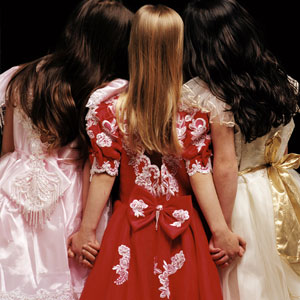
Moon Song
Dress Rehersals
Deborah Paauwe's subjects have never been more than an arm's length away. To look at these photographs is to be locked into a room and hover well inside the comfort zones of strangers. These girls and young women are so close that the artist must have been able to hear the slightest breath or whisper. Paauwe's gaze, and thus ours, has been relentless in its prying. And what defence have these subjects been offered, these young innocents? The decency of the artist's intentions has found expression in deflections such as cropping heads from figures to preserve anonymity, and by posing her subjects in party frocks, transporting subjects and viewers into a playground, or the doll's house which appears in the Small Hours Series, where it's only make believe. It's just dress-ups after all.
Can you really believe that? Is it asking too much of a viewer to look at these images in an Internet age and see innocence or, more to the point, feel innocent as a viewer? Didn't Paauwe insert a dark coda to the process of looking when in her 2000 series, models in communion-white party dresses, stretched on beds as if awaiting an archangel, revealed the worm in the bud, scratches and bruises? The artist says that these blemishes are correctives to 'the gap between idealised beauty and childhood and the realities of everyday existence'. In 2004 the unexpected happened. Faces were admitted. Masks created by face painting rendered these young models as jungle predators or victims, as in Autumn Dusk, arms consigned across the body in a gesture of final repose. In so many images this ambiguity of pose, reinforced by costuming, has deliberately evoked the Sleeping Beauty, a powerful attractor for myths and theories about the nature of womanhood. Persuasive as these connections may be, it remains important to also acknowledge in Paauwe's imagery elements of homage to late-Victorian Neo-Classical figure painting as well as slices of Whistlerian fashionista cool. Wendy Walker, in her recent book on Deborah Paauwe, draws attention to links between the trance-like states of figures and once-held beliefs about the passive and deadly nature of womanhood. Follow this trail and viewers might find themselves in the dark cellar of the doll's house where Symbolist lilies bloom in the half-light and faery maidens bend over recumbent figures. Or perhaps, as in the later 1990s and certainly in the Magic Window series, where, as hair falls across half-revealed faces, an Edvard Munch vampiric woman may be glimpsed. In this manner, Paauwe's images work on a number of different levels and always within a framework of tension where the neat distinctions between childhood, adolescence and adulthood, or between innocence, transgression and evil, are blurred.
Paauwe has raised the stakes in the Magic Window series by dressing her figures in pageant queen dresses, sourced in America. At the time of the first appearance of such imagery the unsolved murder of an American child-pageant queen, Jon Benet Ramsay, was fresh in the memory. Paauwe accepts that social contexts shape readings of her art. Where some will see in her work (as the artist hopes) emblems of universal tenderness, others may choose to see elements of sexual desire. The artist aspires to work as intuitively as possible and reflect on the work later. Titles such as Moon Song and Crimson Pearl have evolved from this intuitive process with the artist matching images (ambiguously or otherwise) with phrases and words garnered from books and magazines. For her, making images remains a business of trying to portray 'the manner in which girls interact with each other in the process of establishing an understanding of the private and public realms of childhood and adolescence'. Peer through a window of the Magic House and see what you will.
© John Neylon 2004